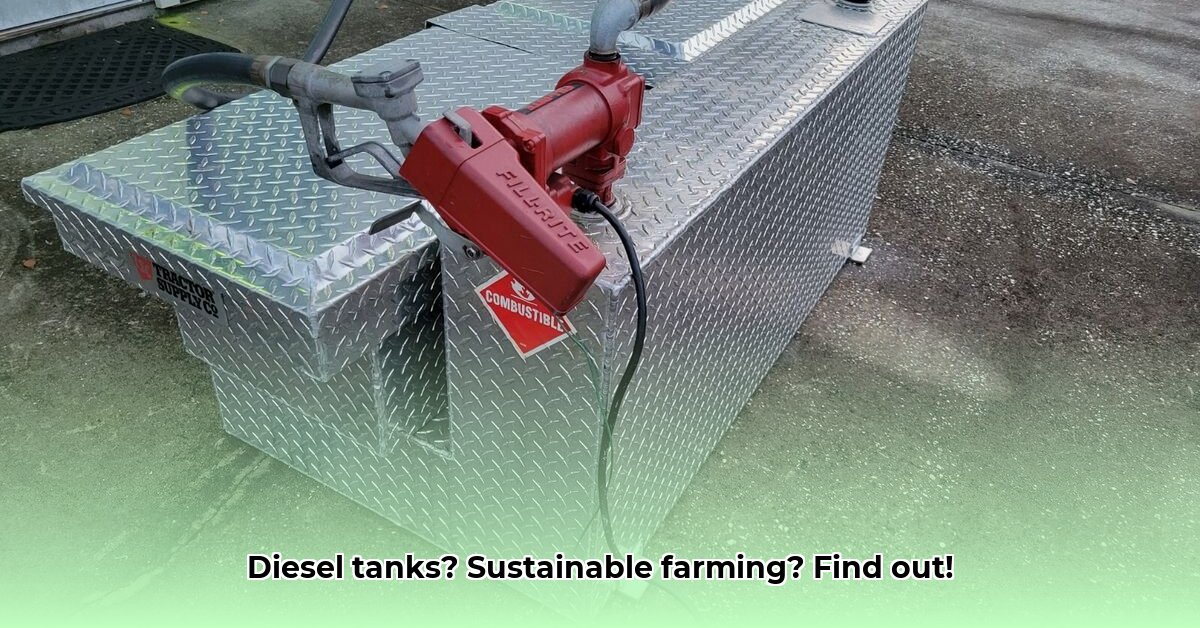
Choosing the right diesel fuel storage solution is a critical decision for any farm, impacting both profitability and environmental responsibility. This guide provides practical advice on selecting, installing, and maintaining diesel tanks from Tractor Supply (or similar retailers) to maximize efficiency and minimize environmental impact within the context of sustainable agriculture. For more info on Tractor Supply diesel fuel cans, see this page.
Assessing Your Farm's Fuel Needs: How Much Diesel Do You Use?
Before selecting a tank, accurately estimate your farm's diesel consumption. Consider the number of diesel-powered machines (tractors, trucks, combines), their average usage, and peak seasonal demands. Overestimating slightly provides a buffer, preventing fuel shortages during busy periods. This careful planning is vital for selecting the correct tank size.
Choosing the Right Tank Size: Matching Capacity to Consumption
Tractor Supply offers various tank sizes. The optimal size depends on your fuel needs. Smaller tanks suit smaller operations or serve as supplementary storage, while larger farms require larger tanks. Consider available space and safe access. Remember, a slightly oversized tank offers a valuable buffer against unexpected fuel demands.
Tank Materials and Features: Steel, Plastic, and Essential Considerations
Diesel tanks are usually made of steel or polyethylene (plastic). Steel tanks offer durability but are susceptible to rust, requiring regular maintenance. Polyethylene tanks are lighter, less prone to corrosion, and often more affordable initially. However, choose UV-resistant plastic for outdoor tanks to prevent sun damage. Regardless of material, seek tanks with these essential features:
- Efficient dispensing valve: For clean, efficient fuel transfers.
- Secure fill cap: To prevent spills and contamination.
- Leak detection system (optional): Provides peace of mind and environmental protection.
Consider above-ground versus underground installation. Underground tanks offer better protection but demand professional installation.
Installing Your Diesel Tank: A Step-by-Step Guide
Proper installation is paramount for safety and longevity. Follow these steps:
- Site Selection: Choose a level, stable location away from ignition sources and flood zones. Poor site selection can lead to significant problems.
- Ground Preparation: Ensure a solid foundation. Professional installation is advised for underground tanks. A stable base prevents settling and leaks.
- Manufacturer's Instructions: Follow the manufacturer's instructions precisely; they are crucial for safe and effective installation. Ignoring them can void warranties and create safety hazards.
- Securing the Tank: Proper anchoring prevents shifting or tipping, especially for above-ground tanks.
- Dispensing System Connection: Connect the dispensing valve and other components securely, ensuring leak-free connections.
- Leak Test: After installation, conduct a thorough leak test. Early leak detection prevents major problems.
Maintaining Your Diesel Tank: Preventative Care for Long-Term Savings
Regular maintenance is crucial to prevent costly repairs and environmental damage. Follow these practices:
- Regular Inspections: Check for leaks, rust, dents, or damage. Early detection allows for prompt repair.
- Tank Cleaning: Periodically remove sediment and debris to maintain efficient fuel flow.
- Fuel Filtration: Utilize fuel filters to protect equipment from contaminants, extending its lifespan.
- Prompt Issue Resolution: Address any issues promptly to prevent small problems from becoming major ones.
Environmental Responsibility: Sustainable Fuel Management Practices
Responsible fuel handling and storage are essential for environmental stewardship. Prevention of spills is paramount. Consider using spill containment around your tank to minimize damage. Diesel fuel is hazardous; careful handling is vital. Dispose of contaminated materials responsibly, according to local regulations. Consult your local environmental agency for proper disposal methods. Remember, environmental responsibility is not just a trend; it's good farming.
Analyzing the Costs: Balancing Initial Investment with Long-Term Savings
Consider the initial cost of a tank against ongoing expenses. Larger tanks are more expensive upfront but may reduce the frequency of fuel purchases, saving time and labour. Factor in lifecycle costs – maintenance, repairs, and potential environmental penalties. A well-maintained tank will pay for itself over time.
Exploring Advancements in Fuel Storage Technology
The field of fuel storage is constantly evolving. Stay informed about advancements in leak detection, compatibility with alternative fuels, and materials science. Industry publications and government resources are invaluable sources of information. Future-proofing your fuel storage practices is an investment in the longevity of your operation.
Concluding Thoughts: Planning for a Sustainable Future
Investing in the right diesel tank is a long-term decision influencing both profitability and environmental sustainability. By carefully considering your needs, choosing the appropriate tank, and implementing a consistent maintenance program, you ensure efficient fuel management, minimize environmental impact, and contribute to a sustainable future for your farm. This is not a one-time task; consistent focus will prove invaluable.